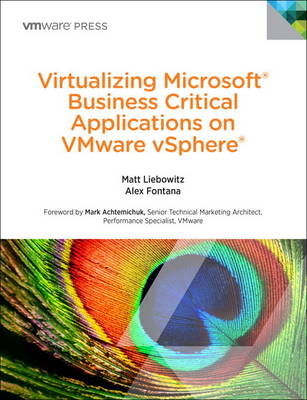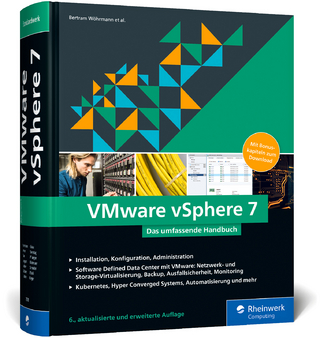
Virtualizing Microsoft Business Critical Applications on VMware vSphere
VMWare Press (Verlag)
978-0-321-91203-9 (ISBN)
- Titel ist leider vergriffen;
keine Neuauflage - Artikel merken
By virtualizing Microsoft’s enterprise applications on vSphere, you can drive down costs while migrating toward flexible, low-cost private cloud architectures. This unique guidebook bridges the gap between the Microsoft and VMware worlds, bringing together the deep knowledge, cutting-edge best practices, and practical techniques you need to succeed.
Leading experts Matt Liebowitz and Alex Fontana present end-to-end coverage of virtualizing Windows Server 2012 AD domain controllers and failover clusters, Exchange Server 2013, SQL Server 2012, and SharePoint Server 2013. They offer indispensable advice on sizing, architecture, performance, availability, monitoring, and metrics.
Throughout, the authors share valuable tips, tricks, and insights from their own experiences. For each Microsoft application, they provide "proof of concept" sample configurations and clearly explain how new features impact virtualization. You’ll also find authoritative, up-to-date guidance on licensing and other issues related to ensuring full support from both Microsoft and VMware.
Coverage includes
• Evaluating the benefits, risks, and challenges of virtualizing Microsoft business critical applications
• Identifying strategies for success associated with people, processes, and technology
• Reviewing VMware vSphere features most important to virtualizing business-critical applications
• Taking advantage of new virtualization-aware features built in to Windows Server 2012 domain controllers
• Designing and configuring vSphere High Availability (vSphere HA) clusters to run Windows enterprise applications
• Reflecting Exchange Server 2013’s new architecture to maximize its performance in virtualized environments
• Leveraging new SQL Server 2012 features to simplify the delivery of high availability on virtual servers
• Reducing SQL Server 2012 licensing costs through virtualization
• Planning, designing, and deploying virtualized SharePoint Server 2013 environments
Matt Liebowitz is currently an advisory solution architect at EMC Consulting with a focus on virtualizing business critical applications. He has been working as a consultant and architect for more than 12 years and has been working with VMware’s virtualization technology since 2002. Matt has written virtualization articles in several industry publications, has presented on virtualization at conferences and at his local VMware user group, and has been a blogger on the topic since 2009. Matt also worked with VMware to create content for their Virtualizing Business Critical Applications competency for VMware’s partners and customers. Matt is very honored to have been named a VMware vExpert each year since 2010, as well as an EMC Elect in 2013. He also holds numerous industry certifications from VMware and Microsoft. Matt maintains a VMware virtualization-focused blog at http://www.thelowercasew.com, is a frequent contributor to the VMware Technology Network (VMTN), and is active on Twitter at @mattliebowitz. When Matt is not out trying to save the world through virtualization, he’s happily playing with his two young kids, Tyler (3) and Kaitlyn (1), and spending time with his wife, Joann. Alex Fontana is currently a solutions architect in VMware’s Global Center of Excellence. During his eight years at VMware, Alex has focused on the virtualization of business critical Microsoft applications for both VMware IT and external customers. In his current role, Alex helps VMware customers to be successful in virtualizing Microsoft applications by conducting technical workshops and authoring technical documentation and blogs. Alex has been a recurring speaker at VMworld since 2008 and VMware Partner Exchange since 2010, and is a frequent contributor to the VMware Technology Network (VMTN). When Alex is not busy writing, working with a customer, or trying to break something in the lab, he can be found at the nearest golf course, on a snow-covered mountain, at a San Francisco Giants game, or in the backyard smoking various cuts of meat. Alex lives in the San Francisco bay area with his wife, Laura, and three kids, Joseph, Sissy, and Sergio.
Foreword xiii
Chapter 1 Introduction to Virtualizing Business Critical Applications 1
What Are Business Critical Applications? 2
Why Virtualize Business Critical Applications? 3
Benefits 3
Risks, Challenges, and Common Objections of Virtualizing Business Critical Applications 11
Performance 11
Supportability 14
Management 15
Reliability 16
Security Risks 17
Complacency 19
Chapter 2 Strategies for Success 23
Understanding People, Process, and Technology 24
People 24
Process 25
Technology 27
Capacity Planning Assessments 30
VMware Capacity Planner 30
Microsoft Assessment and Planning Toolkit 44
Strategies for Success 60
Capacity Planning 60
Develop a Virtualization-First Policy 61
Understand Licensing Requirements 61
Application Silos 62
Virtualizing “Like for Like” 64
Timing Is Key 65
Enterprise Management and Monitoring 66
vCenter Operations Management Suite 66
Chapter 3 Overview of VMware vSphere 73
Why vSphere for Business Critical Applications 74
Proven Performance 74
Efficiency and Scalability 75
Availability 76
vSphere Considerations for Business Critical Applications 77
Processor Virtualization 78
Memory 84
Storage 87
Networking 93
Chapter 4 Virtualizing Windows Server 2012 Domain Controllers 99
Introduction to Active Directory 100
What’s New in Windows Server 2012 Active Directory Domain Services 101
Benefits of Virtualizing Domain Controllers 104
Why Virtualize Domain Controllers? 104
Virtualizing Windows Server 2012 Domain Controllers 108
Virtualized Domain Controller Sizing 108
Time Synchronization 116
Verifying Functionality 124
vSphere Configuration 128
Virtualizing All Domain Controllers 131
Windows Server 2012 Virtualization-Aware Safeguards 132
A Brief History of Virtualized Domain Controller Risks 132
VM-GenerationID 134
Domain Controller Cloning 137
Virtualized Domain Controller Backup 143
Virtualized Domain Controller Deployment 144
Prepare the Virtual Machine 144
Install AD DS 146
Promote to a Domain Controller 148
Chapter 5 Virtualizing Windows Failover Clusters 155
Background 155
Defining High-Availability Requirements 157
What Does High Availability Mean to You? 157
Determining Availability Requirements 159
High-Availability Capabilities 161
VMware vSphere High Availability 162
vSphere Distributed Resource Scheduling 163
vSphere Fault Tolerance 164
Going All-In with vSphere High Availability 165
Windows Failover Clustering on vSphere 167
Cluster Configuration Overview 167
Requirements for Windows Failover Clustering 170
Deploying a Windows Failover Cluster on a vSphere Cluster 172
Setting Up a Windows Failover Cluster on vSphere 172
Building the Cluster Nodes 172
Configuring the Virtual Machines 174
Chapter 6 Virtualizing Exchange Server 2013 193
What’s New in Exchange 2013 194
Consolidated Server Roles 194
Additional Features of Exchange 2013 200
Support for Virtualizing Exchange 2013 205
Understanding Support Requirements 206
Exchange 2013 Sizing on vSphere 208
Exchange Design Elements 209
Virtual Machine Design 211
Application of the Compute Requirements to the Virtual Platform 219
Virtualizing Database Availability Groups 222
The Evolution of Exchange Clustering 222
Exchange DAG Versus Traditional Clustering on vSphere 222
Considerations for Virtualizing Exchange DAG 223
Backup and Recovery of Virtualized Exchange Servers 232
Exchange 2013 Deployment 234
Configure vSphere Network 235
Build the Virtual Machines 248
Create DRS Groups and Rules 260
Configure DAG Heartbeat Threshold 267
Chapter 7 Virtualizing Microsoft SQL Server 2012 273
What’s New in SQL Server 2012? 274
Availability 274
Editions 275
Scalability 276
Performance 277
Why Virtualize SQL Server 2012? 278
Consolidation 279
High Availability with Less Complexity 281
Scalability on Demand 282
Faster Provisioning 282
Preparing for Virtualizing SQL Server 2012 283
SQL Server Capacity Planning 283
SQL Licensing 290
SQL Upgrade Advisor 298
Virtualize Microsoft SQL Server 2012 301
High Availability 302
Allocating CPU to SQL Server Workloads 309
Allocating Memory to SQL Server Workloads 311
Allocating Storage to SQL Server Workloads 317
Allocating Network to SQL Server Workloads 322
Balancing SQL Server Workloads 323
SQL Server Best Practices Analyzer 324
Enforcing SQL Server Licensing with vSphere DRS Rules 325
Performance Testing 328
Backing Up SQL Server Virtual Machines 329
Adjusting Cluster Heartbeat Settings 330
SQL as a Service 332
Deploying SQL Server 2012 337
Deploy Virtual Machines 338
Configure Failover Clustering 340
Install SQL Server 2012 342
Create AlwaysOn Availability Group 344
AlwaysOn Availability Group Dashboard 349
Monitoring SQL Server Virtual Machines 351
Chapter 8 Virtualizing Microsoft SharePoint Server 2013 355
What’s New in SharePoint 2013 356
Deployment Flexibility 357
Distributed Cache 357
Disk I/O Improvements 358
SharePoint Database Improvements 359
Improved Reliability 359
Why Virtualize SharePoint 2013 360
Increased Efficiency 360
Rapid Provisioning 361
Fast and Dynamic Scaling 361
Increased Availability 362
Co-Location of Test and Development Environments 363
Simplified Disaster Recovery 364
Preparing for Virtualizing SharePoint Server 2013 365
Server Roles 366
High Availability for SharePoint Server 370
SharePoint Server Load Testing 372
Virtualizing SharePoint Server 2013 375
Allocating CPU to SharePoint Server Workloads 376
Allocating Memory to SharePoint Server Workloads 377
Allocating Storage to SharePoint Server Workloads 379
Allocating Network to SharePoint Server Workloads 380
Ongoing Performance Monitoring 381
Deploying SharePoint Server 2013 384
SharePoint Server Prerequisites 386
Installing SharePoint Server 2013 389
Configuring SharePoint Server 2013 390
Protecting SharePoint Server Databases with AlwaysOn Availability Groups 393
9780321912039 TOC 7/2/2013
| Verlagsort | NJ |
|---|---|
| Sprache | englisch |
| Maße | 232 x 178 mm |
| Gewicht | 702 g |
| Themenwelt | Informatik ► Betriebssysteme / Server ► Virtualisierung |
| Mathematik / Informatik ► Informatik ► Netzwerke | |
| ISBN-10 | 0-321-91203-9 / 0321912039 |
| ISBN-13 | 978-0-321-91203-9 / 9780321912039 |
| Zustand | Neuware |
| Haben Sie eine Frage zum Produkt? |
aus dem Bereich


